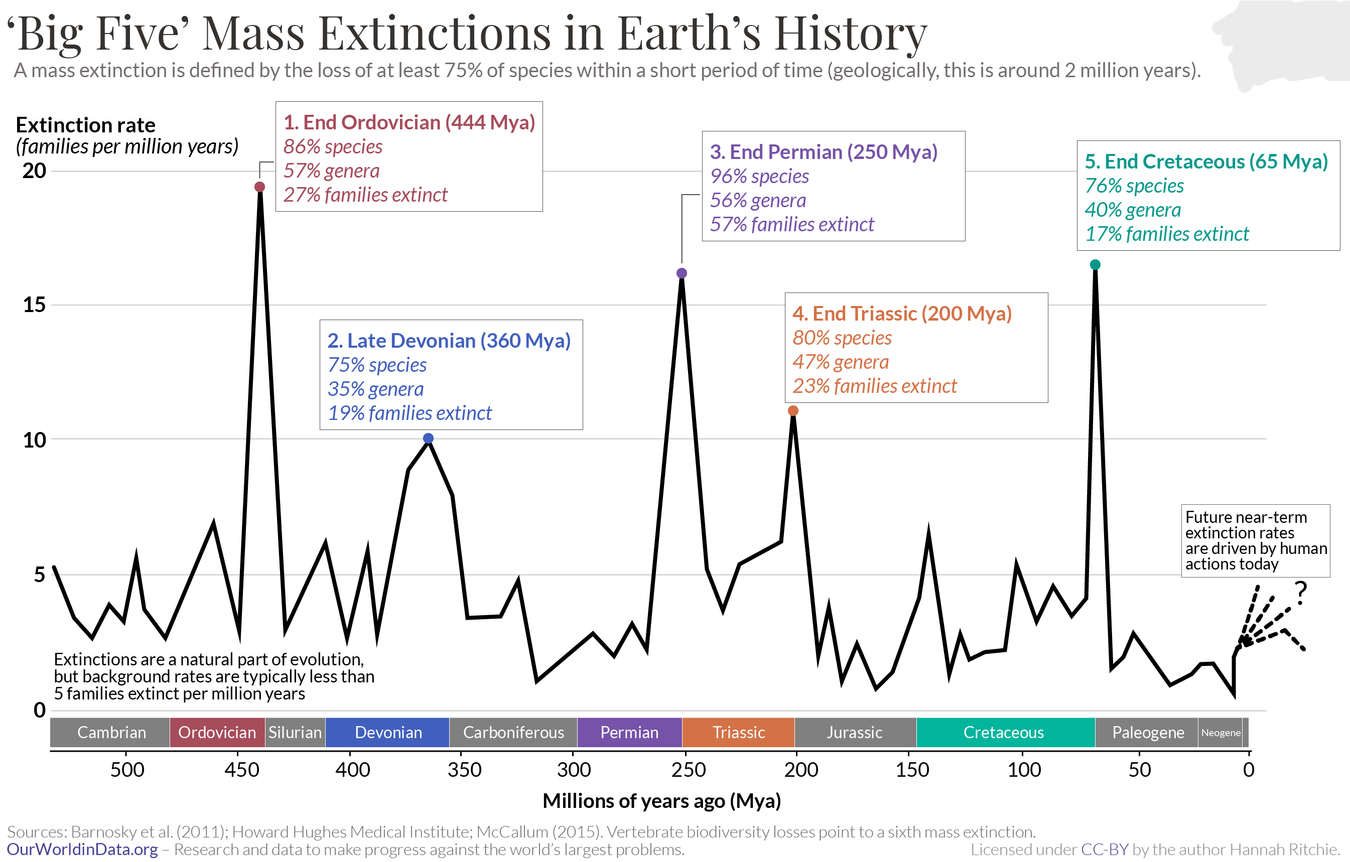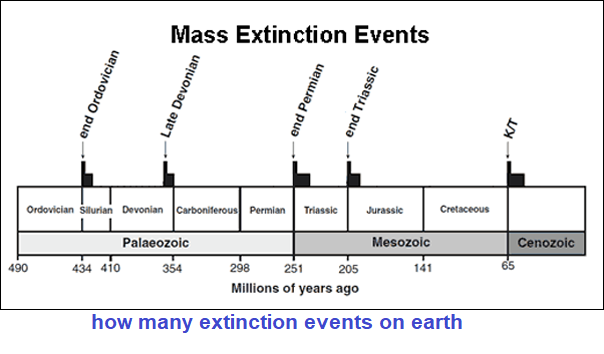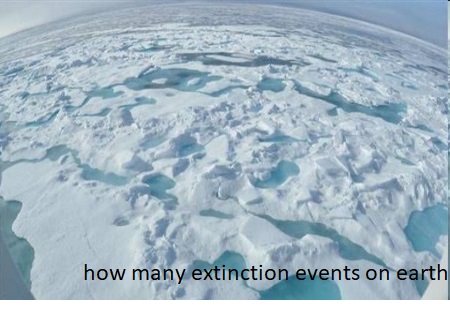
Exploring Earth’s Extinction Events: A Journey Through Time
Earth’s history has been marked by extraordinary events that have significantly impacted the course of life on our planet. One such event is mass extinction, which has led to substantial losses in biodiversity. In this blog post, we will delve into the fascinating world of Earth’s extinction events, exploring their causes and impacts across geological ages.

The Big Five Extinction Events:
1. **Ordovician-Silurian Extinction**: This event occurred around 445 million years ago and was linked to glaciation. It led to a significant decline in marine species.
2. **Late Devonian Extinction**: This event took place about 375-360 million years ago and mostly impacted marine life, causing a significant loss of species.
3. **Permian-Triassic Extinction (The Great Dying)**: This event, which occurred approximately 252 million years ago, remains the most severe extinction event. It devastated up to 96% of all species due to various factors such as volcanic activity and climate change.
4. **Triassic-Jurassic Extinction**: This event, around 201 million years ago, affected both terrestrial and marine species, possibly due to volcanic eruptions and shifting climate patterns.
5. **Cretaceous-Paleogene Extinction (Dinosaur Extinction)**: This event, about 66 million years ago, is famous for wiping out dinosaurs and many other species. It was likely caused by a massive asteroid impact coupled with volcanic disturbances.
Understanding the Impacts:
These extinction events have had profound impacts on the evolutionary trajectories of life on Earth. They led to the emergence of new species, altered ecosystems, and shaped biological diversity over millions of years. The surviving species often underwent rapid adaptations to fill ecological niches left vacant by extinct organisms.
Lessons for Today:
While these ancient extinctions occurred naturally, they offer valuable lessons for our modern world. Human activities such as habitat destruction, pollution, and climate change are driving a current extinction crisis termed the Anthropocene Extinction. Understanding past events can inspire conservation efforts and sustainable practices to protect our planet’s biodiversity.

Throughout Earth’s history, there have been several major extinction events that have had a profound impact on the planet’s ecosystems and biodiversity. Here are five of the most significant extinction events:
1. Ordovician-Silurian Extinction:
Around 445 million years ago, during the transition between the Ordovician and Silurian periods, a global cooling period led to extensive glaciation, which caused sea levels to drop dramatically. Marine habitats were profoundly affected, leading to the extinction of about 60-70% of marine species, including many brachiopods, trilobites, and graptolites.
2. Late Devonian Extinction:
Taking place approximately 375-360 million years ago during the Late Devonian period, this extinction event primarily impacted marine life. The loss of around 70% of marine species occurred due to several potential causes, including climate change, oceanic anoxia (lack of oxygen), and volcanic activity. Reef-building organisms like corals and stromatoporoids were particularly affected.
3. Permian-Triassic Extinction (The Great Dying):
The Permian-Triassic Extinction event, occurring around 252 million years ago, is the most catastrophic extinction event in Earth’s history. It is estimated that 80-96% of all marine species and 70% of terrestrial vertebrate species perished during this time. The causes are complex and likely include massive volcanic eruptions (Siberian Traps), ocean acidification, global warming, and related environmental upheavals.
4. Triassic-Jurassic Extinction:
Around 201 million years ago, the Triassic-Jurassic Extinction event marked a significant shift in Earth’s ecosystems. The decline of various marine and terrestrial species, including many large amphibians and reptiles, occurred due to potential causes like volcanic activity, climate change, and asteroid impacts. However, scientists are still debating the precise mechanisms.
5. Cretaceous-Paleogene Extinction (Dinosaur Extinction):
Approximately 66 million years ago, at the boundary between the Cretaceous and Paleogene periods, a massive asteroid impact occurred near present-day Mexico (Chicxulub impact crater). This impact caused global environmental disruptions such as wildfires, tsunamis, and climate cooling, leading to the extinction of non-avian dinosaurs and many other species. This event paved the way for the rise of mammals and birds in the aftermath.
how many extinction events on earth
Extinction events have a catastrophic impact, but ecosystems have the ability to recover over time and new species evolve to fill vacant ecological niches. This restructuring often leads to increased biodiversity in the long term. We can understand these resilience mechanisms to guide us in conservation strategies focused on ecosystem restoration and resilience-building.
By studying the patterns of species loss during past extinction events, we can reveal valuable information about which types of organisms are more susceptible to extinction. Analyzing these patterns can inform conservation priorities for vulnerable species and ecosystems today. While mass extinctions are often viewed as global events, they can also manifest as regional extinctions with localized impacts. Understanding the interplay between global environmental changes and regional ecological dynamics helps in predicting how current and future environmental changes might affect different regions and biomes worldwide.
Certain regions on Earth, known as biodiversity hotspots, harbor exceptionally high levels of species diversity and endemism. These areas are of particular conservation concern as they face heightened threats from habitat loss, climate change, and human activities. By studying past extinction events and the factors that contributed to species survival or extinction, we can better protect these critical hotspots.
Extinction events are not just periods of loss but also opportunities for evolutionary innovation. Following mass extinctions, new species often evolve distinct traits and adaptations that contribute to their survival and success in changed environments. Understanding the evolutionary processes that occur post-extinction can inform strategies for managing and preserving genetic diversity within species.
how many extinction events on earth
The study of Earth’s extinction events can serve as a powerful educational tool to raise public awareness about the importance of biodiversity conservation and environmental stewardship. Communicating the interconnectedness of species, ecosystems, and geological processes helps foster a sense of responsibility towards preserving Earth’s natural heritage for future generations.
By exploring these additional dimensions of Earth’s extinction events, we gain a more comprehensive understanding of their multifaceted impacts on life, ecosystems, and planetary processes. This knowledge contributes to informed decision-making in conservation, sustainability, and environmental policy to address contemporary challenges and protect Earth’s rich biological heritage.

By examining these extinction events, we gain insights into the dynamic nature of Earth’s ecosystems and the resilience of life over geological time scales. These events remind us of the interconnectedness of species and the delicate balance required to sustain biodiversity on our planet. They also highlight the importance of environmental stewardship and conservation efforts to mitigate human-induced threats to biodiversity today.
Ecological Consequences:
Each of these extinction events had significant ecological consequences. For example, the Permian-Triassic extinction caused the collapse of marine ecosystems and paved the way for new dominant groups of organisms to emerge in the Triassic period. Similarly, the Cretaceous-Paleogene extinction allowed mammals and birds to diversify and occupy ecological niches previously dominated by dinosaurs.
Evolutionary Changes:
Surviving species often undergo rapid evolutionary changes after mass extinctions. These changes include adaptations to new environmental conditions, shifts in body size, changes in feeding strategies, and the development of novel behaviors. The post-extinction periods witness bursts of speciation as surviving lineages radiate into vacant ecological roles.
Climate Change and Extinctions:
Climate fluctuations played a significant role in many extinction events. For example, the Late Devonian extinction coincided with a prolonged period of cooling, leading to habitat loss and stress for marine organisms. Understanding past climate-ecosystem interactions can provide insights into how current and future climate changes might impact biodiversity.
Human Impact:
Although the Big Five extinction events were natural phenomena, today’s biodiversity crisis is mostly driven by human activities. Habitat destruction, pollution, overexploitation of resources, climate change, and invasive species are significant threats to global biodiversity. Learning from past extinctions underscores the urgency of conservation efforts and sustainable practices to mitigate these impacts.
Conservation Strategies:
Studying Earth’s extinction events can inform conservation strategies. By identifying patterns of vulnerability and resilience in past ecosystems, conservationists can prioritize protection efforts for key habitats, species, and ecosystems. Conservation biology aims to prevent further extinctions and restore degraded ecosystems to promote long-term ecological health.
Technological Advances:
Modern scientific tools and methods, such as DNA analysis, remote sensing, and ecological modeling, enable researchers to study past extinctions with unprecedented detail. These technologies not only enhance our understanding of past events but also aid in predicting and mitigating future biodiversity losses.
Earth’s extinction events offer profound insights into the dynamics of life and ecosystems across geological time scales. By studying these events, we gain valuable knowledge about the processes of extinction, adaptation, and ecological recovery. Applying these lessons to contemporary conservation and environmental management can help safeguard biodiversity for future generations.
Conclusion:
Earth’s extinction events provide a glimpse into the resilience and fragility of life on our planet. By studying these events, we can gain insights into the interconnectedness of species and ecosystems. This emphasizes the importance of responsible stewardship of Earth’s resources to safeguard life for future generations.